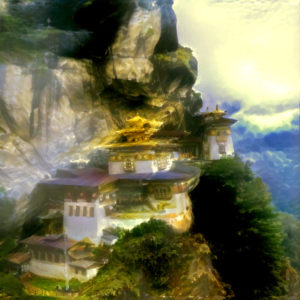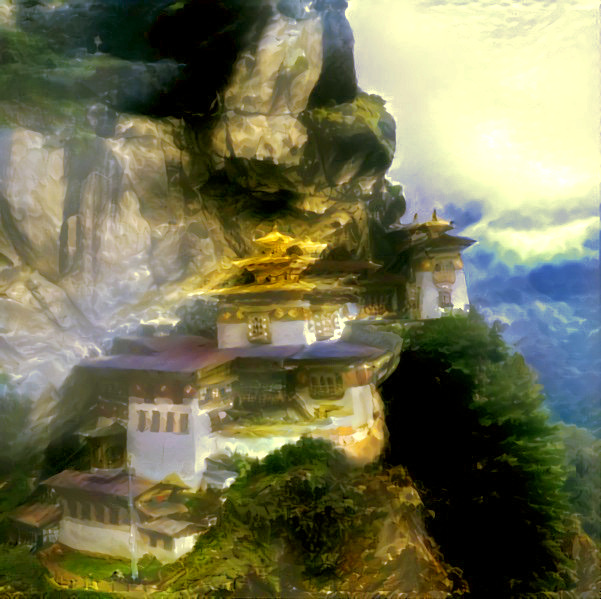 A young man from Europe joined a Japanese Zen Monastery. From the start he had trouble keeping up with the other monks, most of whom entered the monastery as young boys. As the week of meditation called Rohatsu drew near the head monk summoned the western student to his quarters. He spoke only Japanese, and the young student had a hard time understanding him. The head monk explained that, during Rohatsu, all of the students would be expected to meditate for 18 hours a day. He had heard that the student from Europe was already experiencing difficulty with the regular schedule, and if he could not keep up during the week of Rohatsu he should leave the Monastery. This conversation disturbed the young man. He was not at all sure that he could keep up, and yet the thought of being thrown out of the Monastery was not acceptable.
A young man from Europe joined a Japanese Zen Monastery. From the start he had trouble keeping up with the other monks, most of whom entered the monastery as young boys. As the week of meditation called Rohatsu drew near the head monk summoned the western student to his quarters. He spoke only Japanese, and the young student had a hard time understanding him. The head monk explained that, during Rohatsu, all of the students would be expected to meditate for 18 hours a day. He had heard that the student from Europe was already experiencing difficulty with the regular schedule, and if he could not keep up during the week of Rohatsu he should leave the Monastery. This conversation disturbed the young man. He was not at all sure that he could keep up, and yet the thought of being thrown out of the Monastery was not acceptable.
The first day of Rohatsu the European followed the example of some of the younger monks and acquired a charcoal burning hand warmer to fight of the cold of the Meditation Hall. Just prior to entering the hall he lit the warmer and tucked it away out of view under his robe, nestled against his stomach. As he sat for the first 2 hour period the little heater became progressively hotter. What at first was a pleasant warming sensation became a burning in the center of his stomach. He fought down panic, vowing to endure the pain rather than risk being thrown from the meditation hall, and from the monastery. Time ground to a halt and all that existed was the burning. When at last the first meditation period ended he jumped from his seat, raced out side and pulling his robe aside, flung himself into the snow belly first. The other monks were amused and amazed that he would endure such pain. They explained that the heater should first be wrapped in rags before being tucked under the robes. He later found out that he had misunderstood the head monk’s Japanese. What in fact he had been told was that if the intense meditation proved too hard, that they would understand, and he should go into town to rest and rejoin the Monastery at the end of the week.
The fifth limb of Raja Yoga is called Pratyahara and means sense withdrawal. Before the mind can turn in on itself all connections with the external world must be severed. Only when the practitioner is free from external distractions will he be successful at following the inward journey of self discovery. I would like to point out that I am not talking of controlling, or enduring sensations! I am talking about the ability to withdraw from them at will. The true story that I started this lecture with illustrates this common source of confusion in students practicing Meditation, and Pratyahara. Many students suffer through pains and itches while meditating without flinching and believe they have mastered Pratyahara. The truth is, had they mastered Pratyahara there would have been no pain, no itch.
Here in the West we are starting to explore Pratyahara in terms of pain management as an alternative to drug therapy. In fact, many types of pain cannot be controlled with drugs. I once heard Elizabeth Kubla Ross compare chronic pain to being in a room with a roaring fire in the center. Even when flattened against the wall the fire still burns you. In desperation patients often ‘hurl themselves’ into the fire in a vain attempt to put it out. But pain is a bottomless pit which will always exist and cannot be extinguished. Focussing on pain only magnifies it and strengthens it until it fills your entire universe. The secret is to find the door to the room, and leave the room and the fire far behind. Simply walk away from it. This is a form of sense withdrawal. It does not mean enduring pain. It means leaving it behind as you walk down the ‘Eight Fold Path’ of Raja Yoga.
But pain is only one aspect of the senses and by no means the most dangerous. Pleasurable sensations are equally distracting, and pose an even greater threat to the serious student of Raja Yoga. Just as attention magnifies pain, so does attention magnify pleasure. The problem is that while the motivation to withdraw from pain is obvious, the motivation to withdraw from pleasurable sensations is more abstract. Why would one wish to escape from pleasurable sensations? The answer to this question lies in another question: are you content with your life as it is? If yes, then you have no need of Yoga. A ‘general discontent’, the desire to fulfill your true potential, these are the motivations for breaking the cast iron chains of pain as well as the golden chains of pleasure. A chain is a chain is a chain.
This leaves us with the question of how to withdraw from the senses. The key to this problem lies in taking a positive approach to the senses rather than a negative approach. If you are trying not to hear a noise, you are in effect, fixating on it. The harder you try not to hear it, the louder it becomes. What ever you pay attention to becomes brighter, louder, more intense. The solution is to pay attention to the most subtle sound/sight./sensation.
I recommend you begin the practice of sense withdrawal by focusing on sounds. With eyes closed, covered, or lights turned out, listen to all the sounds in your environment. Of all the sounds you can hear, choose to focus on the most subtle. As you improve your ability to focus your mind, the most subtle sound will become louder, and louder. Then ask yourself, is there a more subtler sound beneath the one you are focussing on. Shift your attention to this new sound until it becomes louder.
This is the most important aspect of this practice… do not attempt to “not hear” the louder sounds. Let them come and go. They are of no consequence. Stay focused on the most subtle. As you step back further and further along this chain of sounds you eventually hear your own breathing, beneath that perhaps your heart, beneath that… eventually you are hearing imaginal sounds, sounds of consciousness. Of all of these imaginal sounds, which is the most subtle? Focus on that. Eventually they say that you hear the sound of creation. The echo left over from the big bang, and when asked what does that sound like the sages would reply AAAUUUMMM…. AAAUUUMMM…. AAAUUUMMM.
2 Comments
-
Beautiful article…I have been practising yoga asanas for past few years. was looking at moving forward and deepening and enriching myself further. This is just the kind of understanding and guidance I required. Thank you!
-
Wow, that’s what I was searching for, what a data!
existing here at this weblog, thanks admin of this
web page.Feel free to surf to my web-site :: What Is IBS






